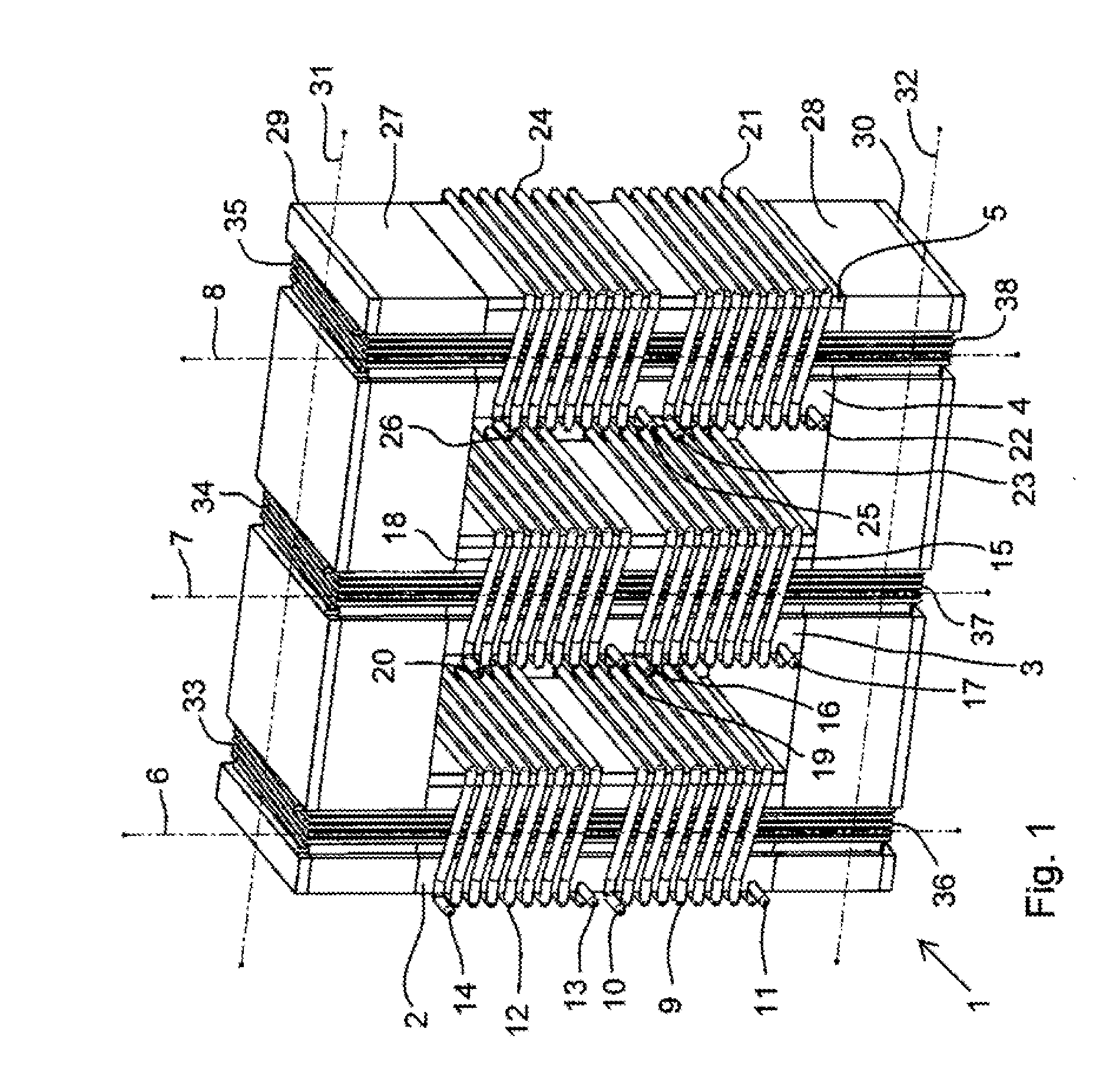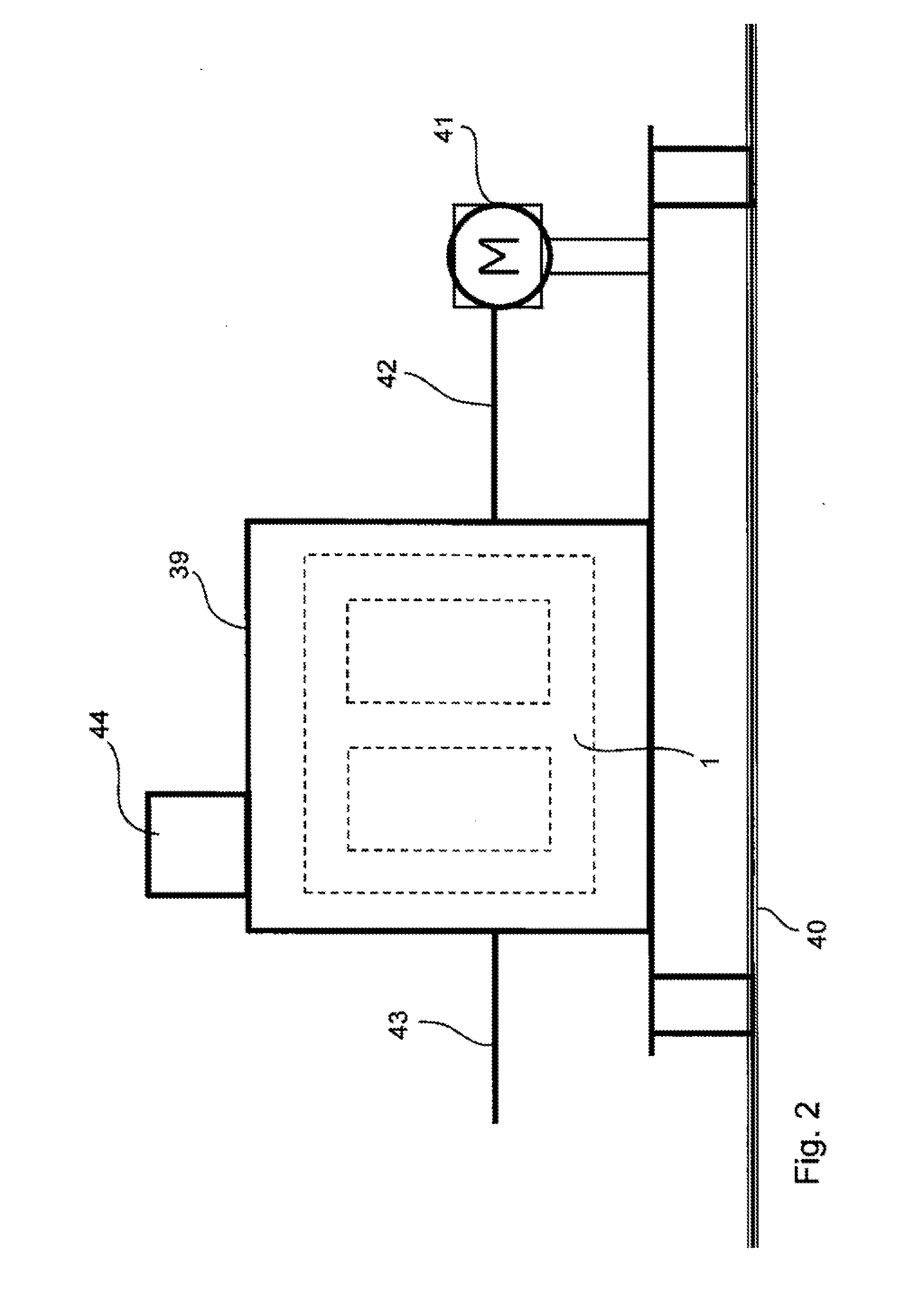Transformer
a technology of transformer and transformer, applied in transformers, power conversion systems, electrical equipment, etc., can solve the problems of mechanical complexity of tap changers, the load of electric motors driving pumps may vary over time, and damage to pump motors,
- Summary
- Abstract
- Description
- Claims
- Application Information
AI Technical Summary
Benefits of technology
Problems solved by technology
Method used
Image
Examples
first embodiment
[0039]FIG. 1 shows a transformer 1 according to the present invention. The transformer 1 comprises a first leg 2, a second leg 3, and a third leg 4. Each one of the legs 2-4, comprises a large number of stacked plates of a magnetic material such as magnetic steel. One of the plates 5 is indicated in the third leg 4. The first leg 2 has a first length axis 6. The second leg 3 has a second length axis 7. The third leg 4 has a third length axis 8. The length axes 6-8 of the legs 2-4 are parallel to each other. A first primary winding 9 having a first tap 10 and a second tap 11 is arranged on the first leg 2. A first secondary winding 12 having a first tap 13 and a second tap 14 is arranged on the first leg 2. The winding axis of the first primary winding 9 is parallel to the winding axis of the first secondary winding 12 and parallel to the length axis 6 of the first leg. A second primary winding 15, with a first tap 16 and a second tap 17, and a second secondary winding 18, with a fir...
third embodiment
[0044]FIG. 4 shows a transformer 1 according to the present invention. The transformer 1 according to FIG. 4 differs from the embodiments in FIGS. 1 and 3 in that the control windings 48, 49, are orthogonal to the control windings in the embodiments of FIGS. 1 and 3 while still being arranged to produce a control magnetic field that is orthogonal to the primary magnetic fields induced by the primary windings 9, 15, 21. A first control winding 48 is wound around the upper yoke 27 and a second control winding 49 is wound around the lower yoke 28. In order to make it possible to wind the control windings 48, 49, as shown in FIG. 4 the yokes 27, 28, are preferably provided with recesses or grooves which form openings 50 between the legs 2-4 and the yokes 27, 28, on the assembled transformer 1. The openings will result in a higher resistance for the magnetic field which leads to losses and a decrease in the overall efficiency of the transformer 1.
fourth embodiment
[0045]FIG. 5 shows a transformer 1 according to the present invention in which the legs 51-53 are tubular. The legs 51-53 are circularly symmetrical around their length axes 6-8. The upper yoke 54 and the lower yoke 55 have through going holes 57, 58 (see also FIG. 6), corresponding to the holes of the legs 51-53. The first primary winding 56, and the first secondary winding 59 are wound through the hole of the first leg 51 and the corresponding holes 57, 58 of the yokes 54, 55. A second primary winding 60 and a second secondary winding 61 are wound in the corresponding way on the second leg 52, and a third primary winding 62 and a third secondary winding 63 are wound in the corresponding way on the third leg 53. The primary windings 56, 60, 62, are arranged to produce primary magnetic fields in the legs 51-53 orthogonal to the length axis 6, 7, 8, of the corresponding leg 51-53. Control windings (see FIG. 6) are wound to produce magnetic fields along the length axes of the legs 51-...
PUM
 Login to View More
Login to View More Abstract
Description
Claims
Application Information
 Login to View More
Login to View More - R&D
- Intellectual Property
- Life Sciences
- Materials
- Tech Scout
- Unparalleled Data Quality
- Higher Quality Content
- 60% Fewer Hallucinations
Browse by: Latest US Patents, China's latest patents, Technical Efficacy Thesaurus, Application Domain, Technology Topic, Popular Technical Reports.
© 2025 PatSnap. All rights reserved.Legal|Privacy policy|Modern Slavery Act Transparency Statement|Sitemap|About US| Contact US: help@patsnap.com



